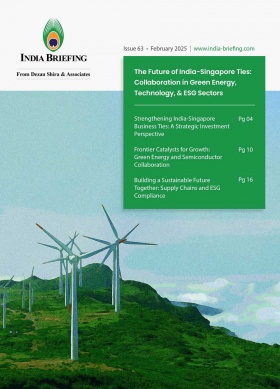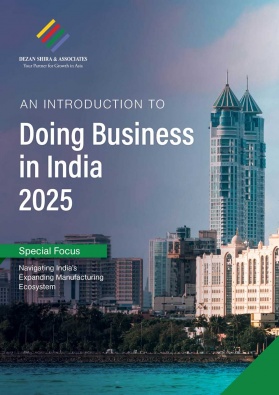Reviewing India’s Economic Pulse Amid Cross-Border Tensions
Amid ongoing tensions and a prolonged diplomatic standoff with Pakistan, India’s economy continues to show resilience. While formal trade remains largely suspended with its neighboring country, investor confidence in India stays strong, backed by limited dependence on Pakistan and robust macroeconomic fundamentals.
Market sensitivity has increased across key industries in the country amid ongoing conflict between India and its neighboring country, Pakistan. Businesses within the region and overseas with India are proactively looking to recalibrate operations to reduce any disruption, protect assets, and maintain production resilience amid growing cross-border tensions between India and Pakistan.
Amid a prolonged diplomatic standoff and the near-complete suspension of formal trade between India and Pakistan, businesses have increasingly turned to indirect trade routes to maintain cross-border commercial activity. Furthermore, foreign investor confidence in India remains largely intact despite the ongoing cross-border conflicts. Analysts attribute this resilience to India’s limited economic dependence on Pakistan and its strong macroeconomic fundamentals. As of March 25, 2025, India’s economy has crossed the US$4 trillion threshold, with financial markets showing minimal volatility against geopolitical activities.
The tactical workaround of indirect trade
According to a report published by the Global Trade Research Initiative (GTRI) on April 25, 2025, titled “How Indian Goods Reach Pakistan Without Crossing the Border,” firms have adopted third-country trade routes to sustain commercial flows. While direct trade between India and Pakistan is virtually frozen, businesses have identified regions such as Dubai, Singapore, and Sri Lanka as pivotal transit hubs.
The two-pager report notes Indian-made goods are first shipped to the ports in these regions and stored in bonded warehouses—customs-free zones that allow goods to be repackaged and relabeled. These rebranded goods, typically marked as “Made in UAE,” are then exported to Pakistan, effectively bypassing official trade barriers. This workaround offers several strategic advantages to traders, such as avoidance of trade restrictions and premium pricing to offset added costs.
Understanding the indirect trade ecosystem: channels, composition, and costs
The success of indirect trade relies on a complex international logistics network. For instance, the United Arab Emirates (UAE) offers a principal transshipment hub for relabeling and re-exporting Indian merchandise goods to Pakistan.
Similarly, Singapore also acts as a key hub for India-manufactured high-value electronics and technology products.
For India’s trade ecosystem, China serves as a transit route for raw materials and semi-finished products, often via Chinese-controlled supply chains.
However, despite its functionality, indirect trade presents certain drawbacks for Indian traders, such as the following:
- Increased costs: When goods pass through multiple handling stages, the extended supply chain and additional warehousing expenses can significantly raise the final price for consumers.
- Reduced value addition: Rerouting goods through intermediary countries shifts the economic gains away from the original exporting and importing nations, benefiting third-party economies instead.
- Challenges for SMEs: Indirect export routes often involve higher costs related to customs, logistics, and storage. These complexities can discourage small and medium-sized enterprises (SMEs), which depend on direct trade routes to keep their export prices competitive.
ALSO READ: Vizhinjam International Seaport: India’s Maritime Leap
Halting trade poses no major disruption to key industries
Despite moments of geopolitical thawing, formal trade between India and Pakistan has historically remained limited due to recurring diplomatic breakdowns. For traders, the trade activities coming to a halt between India and Pakistan do not pose any major disruption to key industries.
|
India-Pakistan Trade Relations (Value in US$ Million) |
|||||
|
Year |
FY 2020-21 |
FY 2021-22 |
FY 2022-23 |
FY 2023-24 |
FY 2024-25 |
|
India’s exports to Pakistan |
816.62 |
326.87 |
513.82 |
627.10 |
1,188.85 |
|
Growth (%) |
– |
-59.97 |
57.19 |
22.04 |
89.58 |
|
India’s imports from Pakistan |
13.97 |
2.39 |
2.54 |
20.11 |
2.88 |
|
Growth (%) |
– |
-82.91 |
6.28 |
692.71 |
-85.69 |
|
Total Trade |
830.58 |
329.26 |
516.36 |
647.20 |
1,191.73 |
Source: Department of Commerce, Ministry of Commerce and Industry, GoI
India’s primary imports from Pakistan are vegetables, fruits, oilseed and fodder, and other edible products. India’s major exports to Pakistan include cocoa and cocoa preparations, organic chemicals, pharmaceutical products, and fertilizers.
Despite the rise in indirect trade, neither country ranks among the other’s top trading partners—underscoring the structural limitations that hinder deeper economic engagement.
Investor sentiment remains resilient despite tensions
The latest cross-border tensions have stirred geopolitical concerns, yet experts suggest foreign investor confidence in India remains largely unaffected. According to a Reuters report published on May 7, 2025, India’s limited economic dependence on Pakistan and strong macroeconomic fundamentals have helped insulate its markets from immediate disruption.
India’s economy recently crossed the US$4 trillion threshold, and markets—ranging from equities to bonds and currencies—have shown minimal volatility in response to the conflict.
Industry leaders indicate that a swift de-escalation could further reinforce investor confidence. Historical patterns suggest that geopolitical events of this nature have had limited long-term effects on Indian financial assets.
India has also demonstrated resilience against global shocks. During the US tariff hikes under Donald Trump, Indian markets continued to perform well, buoyed by domestic consumption and accommodative monetary policies from the Reserve Bank of India (RBI).
While recent developments may cause short-term caution among foreign investors, strong domestic capital flows continue to support the market.
The RBI projects a 6.5 percent GDP growth rate for the current financial year.
Foreign portfolio investors injected around US$1.5 billion into Indian equities during April and early May 2025, though they pulled out approximately US$1.7 billion from the bond markets.
NAV Capital, a wealth management and investment advisory company based in the UAE, noted that while geopolitical uncertainty may slow portfolio flows temporarily, a major investor exodus is unlikely unless the situation worsens any further.
Trade diplomacy and long-term outlook
Analysts emphasize that progress on trade negotiations remains a more decisive factor for investor sentiment. India recently concluded a trade agreement with the United Kingdom and is currently in talks with the US for a bilateral deal.
CLICK HERE: India-UK FTA Finalized After Three Years of Negotiations
Economists note that while short-term market reactions may be uncertain, India’s long-term economic appeal remains intact. Key drivers include trade diplomacy, monetary easing, and sustained domestic growth.
The ongoing border conflict is unlikely to have a long-term impact on foreign direct investment (FDI), as most FDI is concentrated in southern and central regions of India—well removed from the border areas with Pakistan.
|
States/Union Territories Attracting Highest FDI Equity Inflow (Value in US$ Million) |
||||
|
FDI rank |
Region/state |
FY 2022-23 (April-March) |
FY 2023-24 (April-March) |
FY 2024-25 (April-Dec) |
|
1 |
Maharashtra |
14,806 |
15,116 |
16,651 |
|
2 |
Karnataka |
10,429 |
6,571 |
4,496 |
|
3 |
*Gujarat |
4,714 |
7,300 |
5,566 |
|
4 |
Delhi |
7,534 |
6,523 |
4,453 |
|
5 |
Tamil Nadu |
2,169 |
2,436 |
2,903 |
|
6 |
Haryana |
2,600 |
1,908 |
2,843 |
|
7 |
Telangana |
1,303 |
3,029 |
2,071 |
|
8 |
Jharkhand |
6 |
11 |
0 |
|
9 |
*Rajasthan |
910 |
265 |
284 |
|
10 |
Uttar Pradesh |
420 |
334 |
307 |
Source: Fact Sheet on Foreign Direct Investment (FDI) Inflow, DPIIT, GoI.
*Of the top 10 FDI-receiving states, only Gujarat and Rajasthan share a land border with Pakistan.
Conclusion
A key consideration of the cross-border situation would be that India’s broader economic landscape remains stable. The rise of indirect trade channels has enabled continued, albeit unofficial, commercial engagement with Pakistan, helping businesses navigate around formal trade restrictions. At the same time, India’s robust macroeconomic fundamentals, resilient investor sentiment, and ongoing progress in global trade diplomacy have cushioned the economy against major fallout. Unless the geopolitical situation deteriorates sharply, long-term foreign investment and economic momentum are expected to remain on course.
About Us
India Briefing is one of five regional publications under the Asia Briefing brand. It is supported by Dezan Shira & Associates, a pan-Asia, multi-disciplinary professional services firm that assists foreign investors throughout Asia, including through offices in Delhi, Mumbai, and Bengaluru in India. Dezan Shira & Associates also maintains offices or has alliance partners assisting foreign investors in China, Hong Kong SAR, Vietnam, Indonesia, Singapore, Malaysia, Mongolia, Dubai (UAE), Japan, South Korea, Nepal, The Philippines, Sri Lanka, Thailand, Italy, Germany, Bangladesh, Australia, United States, and United Kingdom and Ireland.
For a complimentary subscription to India Briefing’s content products, please click here. For support with establishing a business in India or for assistance in analyzing and entering markets, please contact the firm at india@dezshira.com or visit our website at www.dezshira.com.
- Previous Article India-Belgium Ties Enter New Era of Defense Manufacturing and Scientific Research
- Next Article Indian Pharma on Alert as US Slashes Drug Prices Under MFN Policy








